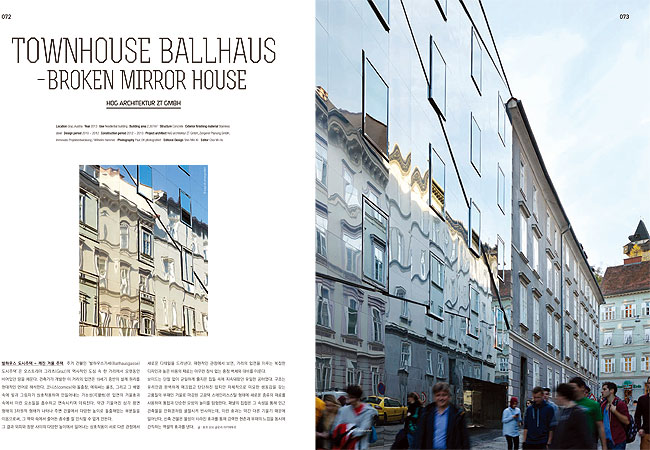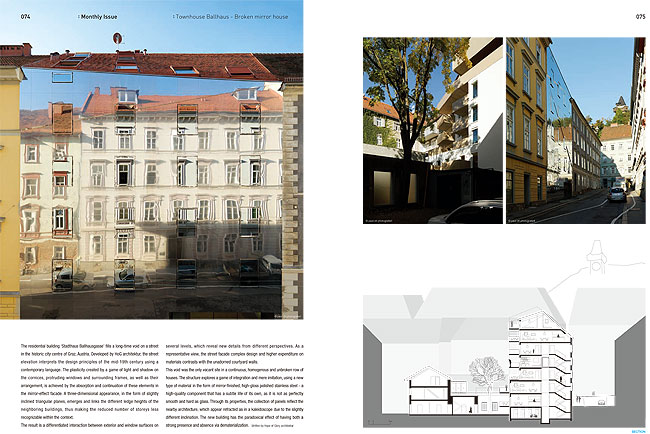TOWNHOUSE BALLHAUS - BROKEN MIRROR HOUSE
Architect : HoG architektur ZT GmbH


발하우스 도시주택 - 깨진 거울 주택 주거 건물인 ‘발하우스가세(Ballhausgasse) 도시주택’은 오스트리아 그라츠(Graz)의 역사적인 도심 속 한 거리에서 오랫동안 비어있던 땅을 채운다. 건축가가 개발한 이 거리의 입면은 19세기 중반의 설계 원리를 현대적인 언어로 해석한다. 코니스(cornice)와 돌출창, 에워싸는 골조, 그리고 그 배열 속에 빛과 그림자가 상호작용하며 만들어내는 가소성(可塑性)은 입면의 거울효과 속에서 이런 요소들을 흡수하고 연속시키며 이뤄진다. 약간 기울어진 삼각 평면 형태의 3차원적 형태가 나타나 주변 건물에서 다양한 높이로 돌출해있는 부분들을 이음으로써, 그 맥락 속에서 줄어든 층수를 잘 인식할 수 없게 만든다. 그 결과 외피와 창문 사이의 다양한 높이에서 일어나는 상호작용이 서로 다른 관점에서 새로운 디테일을 드러낸다. 재현적인 관점에서 보면, 거리의 입면을 이루는 복잡한 디자인과 높은 비용의 재료는 아무런 장식 없는 중정 벽체와 대비를 이룬다. 보이드는 단절 없이 균일하게 줄지은 집들 속에 지속돼왔던 유일한 공터였다. 구조는 유리만큼 완벽하게 매끄럽고 단단하진 않지만 자체적으로 미묘한 생동감을 갖는 고품질의 부재인 거울로 마감된 고광택 스테인리스스틸 형태에 새로운 종류의 재료를 사용하여 통합과 단순한 모방의 놀이를 탐험한다. 패널의 집합은 그 속성을 통해 인근 건축물을 만화경처럼 굴절시켜 반사하는데, 이런 효과는 약간 다른 기울기 때문에 일어난다. 신축 건물은 물성이 사라진 효과를 통해 강력한 현존과 부재의 느낌을 동시에 간직하는 역설적 효과를 낸다.
글: 호프 오브 글로리 아키텍투르
The residential building ‘Stadthaus Ballhausgasse’ fills a long-time void on a street in the historic city centre of Graz, Austria. Developed by HoG architektur, the street elevation interprets the design principles of the mid-19th century using a contemporary language. The plasticity created by a game of light and shadow on the cornices, protruding windows and surrounding frames, as well as their arrangement, is achieved by the absorption and continuation of these elements in the mirror-effect facade. A three-dimensional appearance, in the form of slightly inclined triangular planes, emerges and links the different ledge heights of the neighboring buildings, thus making the reduced number of storeys less recognizable within the context. The result is a differentiated interaction between exterior and window surfaces on several levels, which reveal new details from different perspectives. As a representative view, the street facade complex design and higher expenditure on materials contrasts with the unadorned courtyard walls. This void was the only vacant site in a continuous, homogenous and unbroken row of houses. The structure explores a game of integration and mere imitation, using a new type of material in the form of mirror-finished, high-gloss polished stainless steel - a high-quality component that has a subtle life of its own, as it is not as perfectly smooth and hard as glass. Through its properties, the collection of panels reflect the nearby architecture, which appear refracted as in a kaleidoscope due to the slightly different inclination. The new building has the paradoxical effect of having both a strong presence and absence via dematerialization.
Written by Hope of Glory architektur
건축문화 2016년 4월호 [Monthly Issue]페이지 © 에이엔씨출판(주)